
DNA and associated analysis tells us a lot about our ancestry. It is a relatively new field, but I can no longer imagine doing genealogy without it. Much of my work with DNA has focused on finding matches to breakdown brick walls. This article touches on information DNA provides about our ethnicity. I compare results from 3 different companies using my dad’s DNA.
Ethnicity Estimates
Ethnicity estimates is an area of DNA analysis that is an evolving science. Each company has slightly different regions. In addition, each company has a growing and changing base of data that is used to determine a person’s ethnicity. Thus, the estimates and even regions that apply to a person continue to be in flux.
Ethnicity estimates are based on unique elements of DNA that evolved over time. Thus, they don’t necessarily align with where a person lives or where their ancestors most recently lived. Ethnicity provides clues to where a family lived 1,000 or more years ago. For example, someone might have family that immigrated from Germany. However, their ethnicity from a DNA company might indicate some percentage Russian. That simply means that one or more of their ancestors was originally from Russia.
Expectations From Traditional Genealogy
For people like Rod’s mom, her expected ethnicity makeup is quite clear as her grandparents all immigrated to the United States from Germany. However, when your ancestors have been in the United States a long time, your expected ethnicity makeup is a bit more complicated.
In Dad’s case, it is very complicated as his earliest known ancestor in America arrived in 1621. Most of his family lines arrived in America by 1800. The last branch of his family to arrive in the United States left Europe 200 years ago, but took a bit of a detour through Canada before making their way southward.
Thus, a lot of generations and a lot of different families join together to form Dad’s family tree. It isn’t feasible to discuss all of them with regards to expected ethnicity. Therefore, this article focuses on what traditional genealogy says about where his great-grandparents’ direct paternal family line’s may have lived before coming to the United States.
The 8 Key Family Lines
McCracken
Genealogy research indicates that our McCracken ancestors most likely moved to the United States from Ireland. However, the name McCracken is derived from the Clan McNaughton in Scotland. Thus, it seems we may have ancestors in both Scotland and Ireland.
Matteer
According to census records, Mathias Matteer, our earliest confirmed Matteer ancestor, was the son of immigrants. His father was born in France and his mother in Canada. Although not proven, it appears that it may have been his grandfather, rather than his father, who was born in Alsace, France. In either case, genealogy would indicate that he had ancestry in the region along the French-German border.
Ellis
Our Ellis relatives in Europe are unknown. People with the name Ellis or other forms of it lived in many different places. However, the name seems to have originated in England.
nicholson
Our Nicholson family also dead ends in the United States. It was very common in the British Isles.
Peelle
Lawrence Peelle sailed to America from England. He appears to have sailed on the Margaret and John over the winter of 1620-1621. The belief is that he was born in England.
Peel Castle is on St. Patrick’s Isle which is connected to Isle of Mann, which has a town named Peel. Additionally, Piel Castle is on Piel Island off the cost of northwest England. Whether Lawrence had a connection to either of these places is unknown.
Johnson
According to House of Names, Johnson is the second most common surname in the United States. The name was common in England, but our knowledge of the family ends in North Carolina.
Jury
The Jury family immigrated first to Canada and then to the United States. They were from Sussex, England.
Willett
The Willett family immigrated to Canada. Then, Ellenor (Ellen) (Willett) Jury immigrated with some of her children to the United States.
1 Person – 3 Different Views
This section takes a look at Dad’s ethnicity as provided by 23andMe, MyHeritage, and Ancestry. As you look at them, you will note significant differences in both the ethnicity and the detail provided.
23andMe
Regions
The areas highlighted in color indicate the regions 23andMe has identified as locations associated with unique attributes of Dad’s DNA.

The graph shows that they have identified Dad as basically being a Northwestern European. They further break down the categories to show more specific (sub)regions.
The (sub)regions focus his ancestral roots in on being British and Irish with small amounts of the other areas.


This chart is something I could have guessed from traditional genealogy given most of his 8 key family lines have likely ties to the UK.
MyHeritage
Regions
The regions on the MyHeritage map are shown in various colors. The areas that are grayish and outlined are genetic groups. Those will be discussed in the following section.
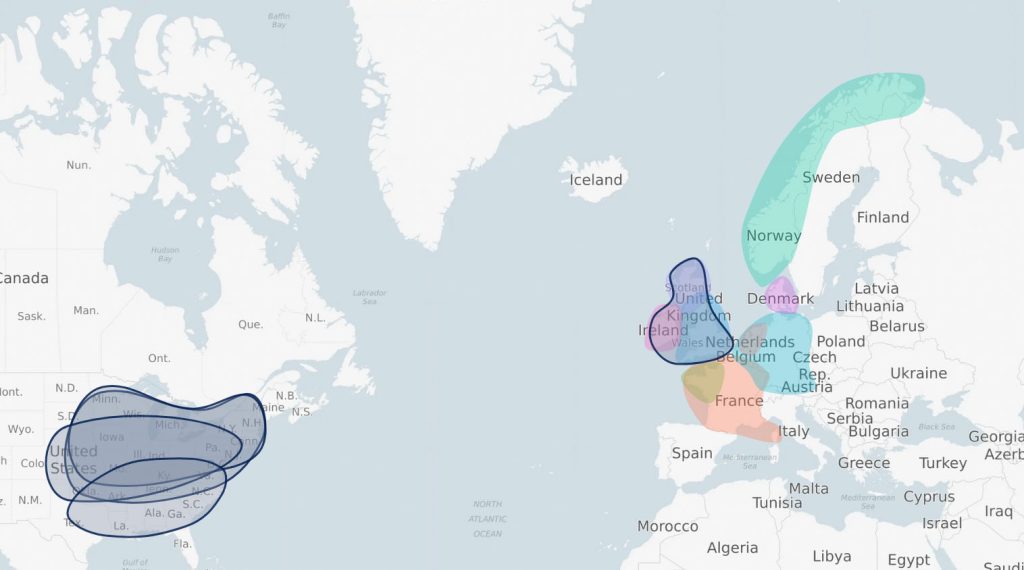

The regions highlighted are those that MyHeritage has determined for Dad. The chart shows the percentages for each region.
If we look at Dad’s key families, we would expect French, Irish, Scottish, and English. In addition to these families, I know of connections to Germany. Thus, I was not surprised by Germanic and related regions.
This leaves us with the surprise regions of Norwegian and Breton. Dad has no known connection to Norway. However, the distance between Norway and several of the other regions is not large. Thus, one or more ancestors could have easily migrated to one of the other regions.
Brittany, France (Breton) is on the opposite side of France from where Dad’s Matteer ancestors are believed to have lived. It seems most likely that they migrated to England.
The other surprise is the small percentage Irish. With the name McCracken, even knowing it had roots in a Scottish Clan, we always thought of ourselves as being a good percentage Irish.
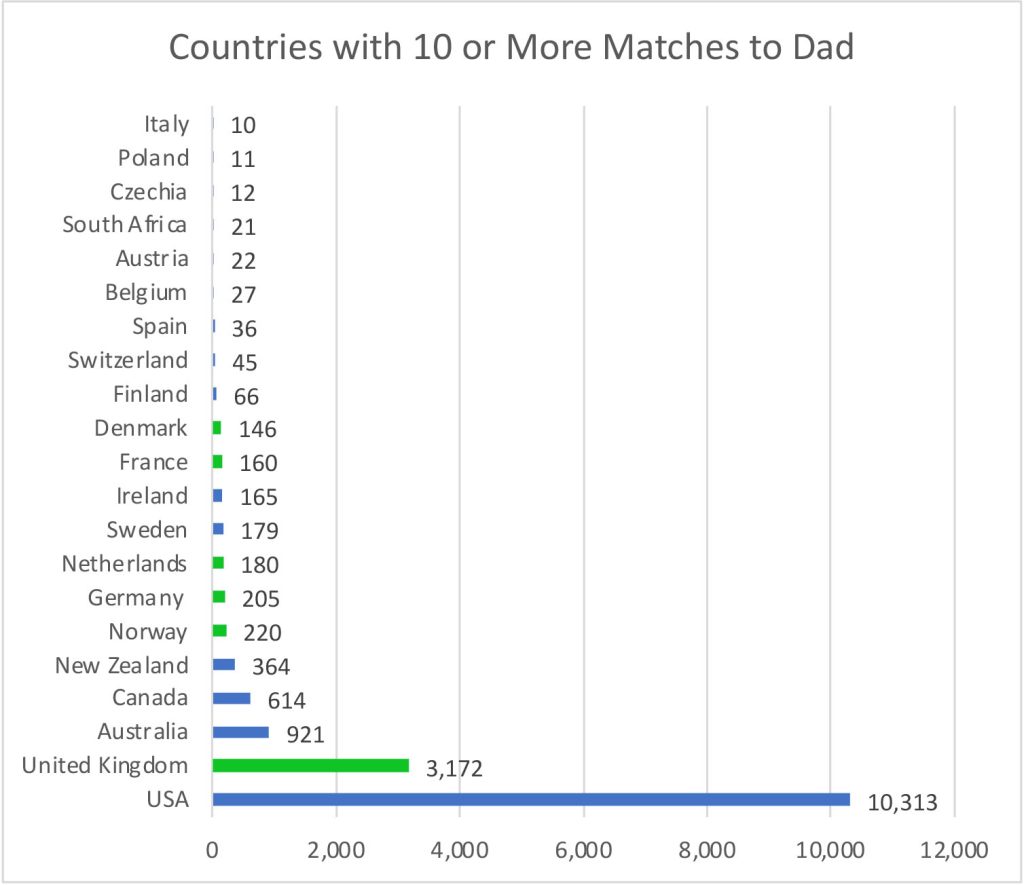
Location of DNA matches
MyHeritage also provides the number of DNA matches a person has in each country. This provides an interesting view when you consider it along with the regions.
The chart shows a list of countries and number of matches in each to Dad. Only countries with 10 or more matches are included in the chart. Countries with a green bar are in countries represented by the regions MyHeritage identified.
Genetic Groups
MyHeritage also provides what they call genetic groups. These are areas where a person shows strong genetic associations to other people that live or lived in the area. My Heritage identified five genetic groups.
- UK and Ireland
- Northeastern and Midwestern USA
- Midwestern USA #9
- Northeastern and Midwestern USA and Canada (Ontario) #2
- Southern USA
For each genetic group, MyHeritage used thousands of DNA kits and they state that they have high confidence in each group.
All of these groups has its specific makeup of settlers. However, all of them include settlers from the UK. All these genetic groups except the “UK and Ireland” group include German backgrounds. Each of the genetic groups include places that Dad’s ancestors lived.
Ancestry
Regions
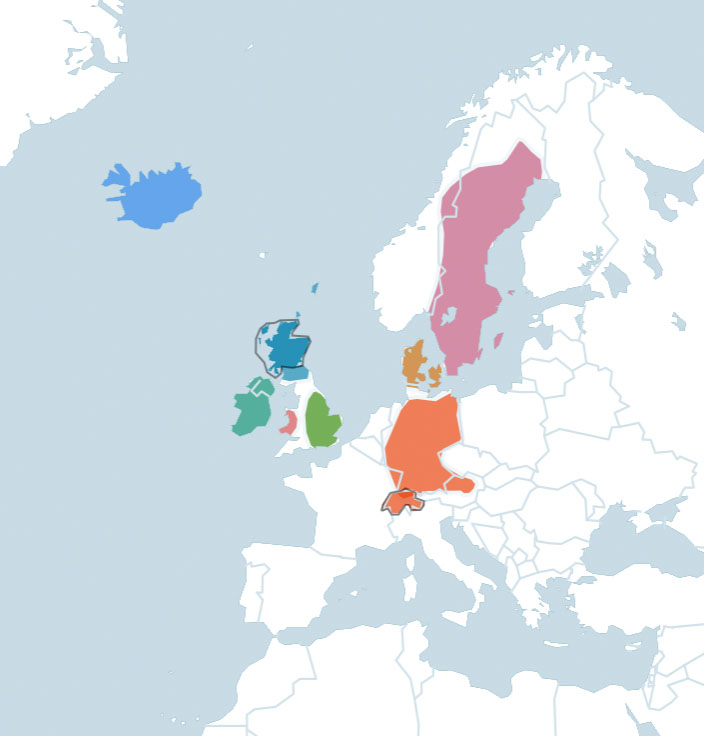
The regions highlighted are those that Ancestry has determined for Dad. You will note that the regions are somewhat similar to those of MyHeritage. Yet, there are also differences.
The chart shows the percentages for each region. Ancestry also provides a range. For example, Scotland is 18%. The range, however is 11% to 32%. My understanding is that in comparisons to their data, 18% is the most likely scenario. However, Ancestry found it possible, but less likely, in other parts of the range.
If we look at Dad’s key families, traditional genealogy would lead us to expect the regions of Ireland, Germanic Europe, Scotland, and England & Northwestern Europe. Within the Scotland region, Ancestry ties Dad to the Scottish Highlands and Central Lowlands subregion. The only other subregion Ancestry identifies for Dad is the French and German Switzerland subregion, which is likely attributed to the Matteer family.
Beyond these regions, Wales also seems likely since Peel Castle is in the vicinity of Wales. You will later see how this reasonable assumption is debunked and why Wales must come into play another way.

Ancestry associated Dad with the region of Sweden; whereas, MyHeritage associated him with Norway. Although traditional genealogy has yet to uncover a connection to either place, it seems likely that each company is picking up on a DNA attribute, but associating it to different countries.
Denmark and Iceland are the additional surprise regions. Denmark is close to both the German region and Sweden. Thus, the region of Denmark does not seem like a stretch. MyHeritage also identified this area.
Iceland, however, is a huge surprise. I am wondering if it is one of those regions that comes and then goes again as more is learned about the region. Only time will tell.
Ethnicity – Split By Parent
Ancestry takes ethnicity a step further and splits it between ethnicity that can be attributed to a person’s mother and a person’s father. The following chart shows Dad’s ethnicity makeup on the right. On the left, it shows the split between his mother and his father. From this we can check to see if he really inherited ethnicity from whom we think he did.
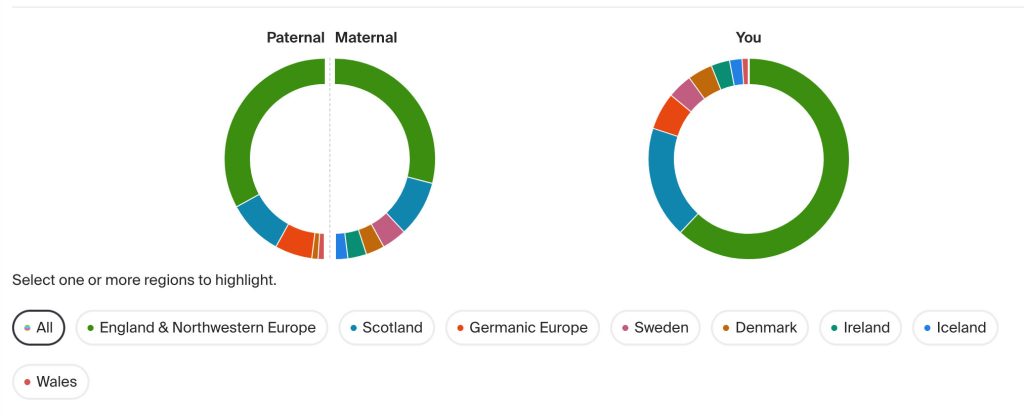

Each of his parents provided approximately 50% of Dad’s DNA. However, DNA inherits randomly. Thus, from a given parent you might not get any DNA that indicates one ethnicity, some of another, and all of another.
If we consider the key families, it is definitely no surprise that Dad’s mother, Nellie (Peelle) McCracken, provided a good amount of England & Northwestern Europe DNA as her mother’s ancestors all came from England and her father’s early ancestors also came from England. Traditional genealogy for key families of Dad’s father, Joseph Andrew McCracken, haven’t uncovered the same strength of ties to England. However, traditional genealogy has uncovered some more distant families with ties to England.
Scotland is a bit opposite as I would expect more of Scottish DNA to come from Dad’s paternal side. Matter of fact, I don’t know where that much Scottish DNA would have come from on his maternal side.
Germanic Europe is no surprise. Dad’s Matteer family may fall into that category as they were from an area in France along the border with Germany. Additionally, the Storm(s)(es)/Sturm family that married into the Ellis line was from Germany and based on a huge number of matches to this family, I am sure they are contributors to the German percentage.
The two other regions of interest are Iceland and Wales. From this data, we find that the tie to Iceland was on Dad’s mom’s side. Similarly, we learn that the tie to Wales is on his father’s side. Thus, the assumption made earlier that Wales might be tied to the Peelle family is ruled out.
Ethnicity – Split By Chromosomes
Ancestry also provides a map of the ethnic regions to the chromosomes. The following image shows the mapping of the regions to Dad’s DNA. The top bar on each chromosome pair represents Dad’s father’s side and the bottom bar represents his mother’s side. The dominance of England & Northwestern Europe is quite evident. And, we can see that the Iceland region is associated with chromosome #15.
Ancestry also provided the ability to compare

Ethnicity Comparisons
 Ancestry also provides the capability to compare your regions with those of your DNA matches. The chart shows the DNA regions for Dad, my sister, and myself.
Ancestry also provides the capability to compare your regions with those of your DNA matches. The chart shows the DNA regions for Dad, my sister, and myself.
A couple new regions are added, which would have come from my mom’s side. Additionally, several ethnic regions drop out in my sister and me.
Despite the fact that Mom never did a DNA test, several things can be learned about my mom’s ethnic regions. First, we know that her ethnic regions must greatly overlap with dad’s regions. We also know that at minimum Mom has 18% England & Northwestern Europe since my sister has 80% in this region. However, it is likely that she has much more. We also know she had ancestors from Scotland, Finland, and Norway.
Journeys
Ancestry’s “Journeys” are similar to MyHeritage’s “genetic groups.” They are areas where a person matches or is expected to match a number of people because their ancestors and other relatives lived in the location. Generally, journeys are more recent.
To date, Ancestry has identified three Journeys for Dad:
- Eastern South East England, Delaware Valley
- Chesapeake & Midwest Settlers
- St. Louis, Missouri & Western U.S. Settlers.
Eastern South East England
Ancestry specifically ties Dad’s family to two specific areas within this Journey. The West Sussex, West Surrey & Eastern Surrey & Kent area (darkest green) is definitely tied to the Jury and Willett families. They moved from this area to Canada before coming to the United States.
The other specific place is Greater London to Brighton (medium green). This is likely also tied to these families, possibly through people who married into the family.

Delaware Valley, Chesapeake & Midwest Settlers
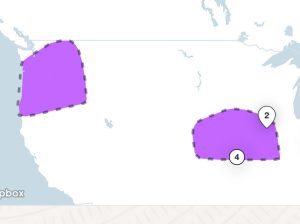
St. Louis, Missouri & Western U.S. Settlers
This area includes much of Kansas, Missouri, and Iowa. At least one member of each of the key families lived within this journey. Despite the fact that none of Dad’s direct ancestors lived in the northwest, this was a very common destination for people that passed through Kansas and Missouri. I have found people in many different families that had one or more family members that moved to the northwest.
So, what is missing in these journeys? Probably the area that I would expect most is North Carolina, Virginia, and Kentucky. Regions containing them might show up eventually. However, it is possible that they don’t show up because much of our family left those areas 200 or more years ago.
Ancestry provides more information about the regions, journeys, and examples of people that lived in each of the regions. They also provide details about their processes and research.
